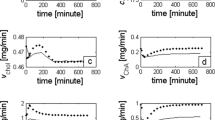Summary
Both chenodeoxycholic acid and lithocholic acid intensified the production of cholesterol gallstones when added at the level of 0.1% to a basal diet under conditions in which production of cholesterol gallstones by the unsupplemented basal diet was low or moderate. But the effect of chenodeoxycholic acid was somewhat more marked than the effect of lithocholic acid.
When added at the 0.1% level to a basal diet under conditions in which the unsupplemented basal diet produced no cholesterol gallstones but a moderate incidence of amorphous pigmented gallstones, chenodeoxycholic acid gave rise to abundant formation of cholesterol gallstones, whereas only slight production of cholesterol gallstones was seen with dehydrocholic acid and deoxycholic acid and none with cholic acid. Occurrence of amorphous pigmented gallstones was more frequent in the group of animals receiving the unsupplemented basal diet than in the groups receiving additions of dehydrocholic, deoxycholic, cholic, and — especially — chenodeoxycholic acid.
The importance of the stock diet used in the hamster colony to the development of gallstones occurring when the animals are exposed to the artificial experimental regimen is mentioned.
Zusammenfassung
Nicht nur Chenodeoxycholsäure, sondern auch Lithocholsäure intensivierte die Bildung von Cholesterin-Gallensteinen, wenn als Zulage in der Höhe von 0,1% zu einer kÜnstlichen Basal-Nahrung gegeben unter Bedingungen, unter denen die Bildung von Cholesterin-Gallensteinen durch die Basal-Nahrung allein nur gering oder mäßig war. Die Wirkung von Chenodeoxycholsäure war etwas stärker als die Wirkung von Lithocholsäure.
Wenn als Zulage in der Höhe von 0,1% zu einer Basal-Nahrung gegeben unter Bedingungen, unter denen die Basal-Nahrung allein nicht zur Bildung von Cholesterin-Gallensteinen, sondern — in mäßigem Umfange — zur Bildung von amorphen, pigmentierten Gallensteinen Anlaß gab, fÜhrte Chenodeoxycholsäure zu reichlicher Bildung von Cholesterin-Gallensteinen, während Bildung von Cholesterin-Gallensteinen unter dem Einfluß von Dehydrocholsäure und Deoxycholsäure nur gering war, und unter dem Einfluß von Cholsäure nicht vorkam. Das Vorkommen von amorphen, pigmentierten Gallensteinen war häufiger in der mit der Basal-Nahrung ohne Zulage von Gallensäuren gefÜtterten Gruppe von Hamstern als in den mit Zulage von Dehydrocholsäure, Deoxycholsäure, Cholsäure und Chenodeoxycholsäure gefÜtterten Gruppen, besonders in der zuletzt erwähnten Gruppe.
Die Bedeutung der in der Hamster-Kolonie benutzten „Stock-Nahrung“ fÜr die Entwicklung von Gallensteinen unter dem Einfluß der kÜnstlichen Experimental-Nahrung wird erwähnt.
Similar content being viewed by others
References
Dam, H., I. Prange andE. SØndergaard, Z. Ernährungswiss.11, 80–94 (1972).
Dam, H., andF. Christensen, Z. Ernährungswiss.2, 154–159 (1962).
Dam, H., I. Prange andF. Christensen, Z. Ernährungswiss.6, 97–106 (1965).
Koller, S., in:H.M.Rauen, Biochemisches Taschenbuch, Bd.2, 988 (Berlin 1964).
Author information
Authors and Affiliations
Rights and permissions
About this article
Cite this article
Prange, I., SØndergaard, E. & Dam, H. Alimentary production of gallstones in hamsters. 26. The influence of orally ingested lithocholic, cholic, dehydrocholic and deoxycholic acids on gallstone production compared with the influence of chenodeoxycholic acid. Z Ernährungswiss 12, 92–107 (1973). https://doi.org/10.1007/BF02021948
Received:
Published:
Issue Date:
DOI: https://doi.org/10.1007/BF02021948




